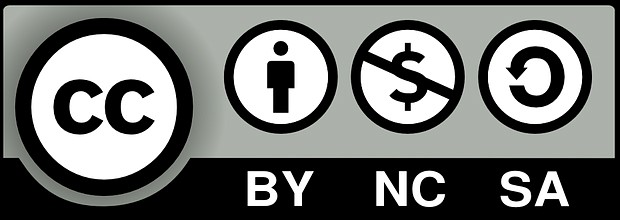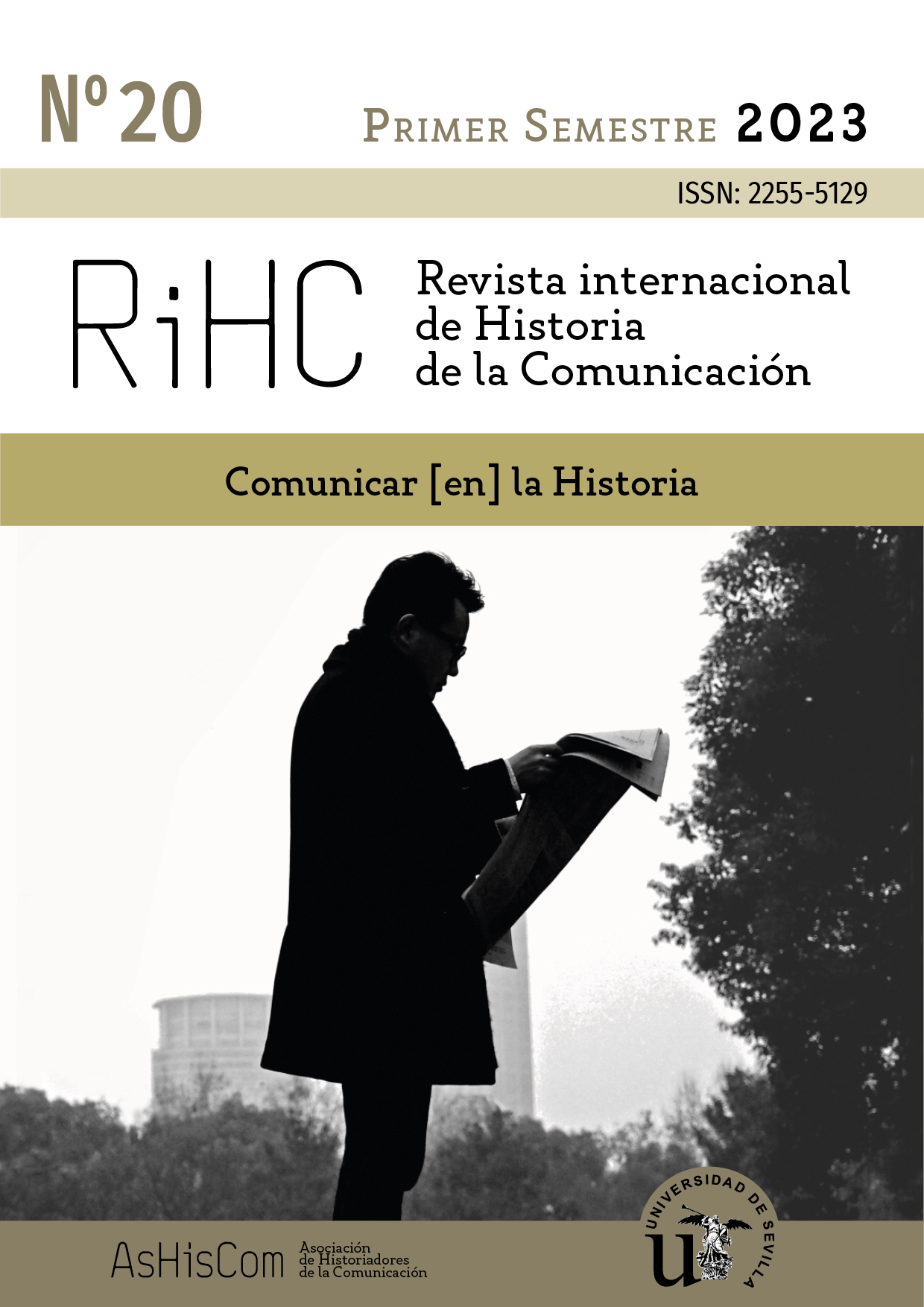La Historia de la Comunicación en la academia centroamericana (1980-2021)
DOI:
https://doi.org/10.12795/RIHC.2023.i20.04Palabras clave:
Centroamérica, historia, comunicaciónResumen
Este texto tiene como objetivo analizar una muestra de los textos académicos referentes a la Historia de la Comunicación en Centroamérica que se han publicado en formato de libros con respaldo editorial, artículos en revistas reconocidas e indexadas y en informes de organismos internacionales, y aquella generada por autores adscritos a instituciones académicas centroamericanas desde 1980 hasta 2021. Luego de un recorrido por los trabajos académicos realizados en Centroamérica en materia de comunicación, fueron seleccionados los textos que específicamente trataban la Historia de la Comunicación. Con estos, se realizó un balance de la producción científica en materia de la Historia de la Comunicación en la región. El propósito de este ensayo es responder a las siguientes interrogantes: ¿Cuáles son los temas que se han estudiado en el campo de la Historia de la Comunicación en la región en las últimas cuatro décadas? ¿Cuál ha sido el abordaje metodológico? Dado que se trata de una zona convulsa en demasía, situación que permea todos los campos y particularmente la academia, ¿cómo influye el contexto en el proceso de construcción de la Historia de la Comunicación? En resumen, se analizan las principales tendencias en la Historia de la Comunicación en la región y finalmente se propone una agenda temática en esa materia que evidencie los campos que aun requieren ser investigados.
Descargas
Citas
ALAN CRANFIELD, G. (1978): The Press and Society, London, Longman Group Limited.
ANDERSON, P. (1991): The Printed Image and the Ttransformation of Popular Culture 1790-1860, New York, Oxford University Press.
ANGLÍN FONSECA, LLOYD (2021): Humor gráfico y nación en Costa Rica 1917-1948. San José, Editorial Costa Rica.
ANTÓN PELAYO, J. (1998): La Herencia cultura:. Alfabetización y lectura en la ciudad de Girona (1747-1807), Barcelona, Universidad Autónoma de Barcelona.
Balance de InSight Crime de los homicidios en 2021. Argentina, 1 de febrero 2022.
BORDERÍA, E., LAGUNA, A., MARTÍNEZ, F. (1998): Historia de la Comunicación social, voces, registros y conciencias, Madrid, Editorial Síntesis.
BORDERÍA, E., MARTÍNEZ, F., GOMEZ, J. (2015): El humor frente al poder. Madrid, Biblioteca Nueva.
BOUZA, F. (1998): Imagen y propaganda. Capítulos de historia cultural del reinado de Felipe II. Madrid, ALCAL.
BROOK, T. (1991): The New Historicism and Other Old-Fashioned Topics, Princeton, NJ: Princeton University Press.
BRYAN PALMER, P. (1990): Descent into Discourse: The Reification of Language and the Writing of Social History, Philadelphia, Temple University Press.
BURKE, P. Y PORTER, R. (1987): The social history of language, London, Cambridge University Press.
BURKE, PETER Y ASA, BRIGGS. Ed. (2002), De Gutenberg a Internet. Una historia social de los medios de comunicación, Madrid, Taurus.
CAVALLO, G. y CHARTIER, R. (1998): Historia de la lectura en el mundo occidental, Madrid, Santillana.
CHADWICK, O. (1983): The Secularización of the European Mind in the 19 th Century, Cambridge: Cambridge University Press.
CHARTIER A. Y JEAN HÉBRARD, J. (1994): Discursos sobre la lectura (1880-1980), Barcelona, Gedisa.
CHARTIER, R. (1992): El mundo como representación: Historia cultural: entre práctica y representación, Madrid, Gedisa.
CEPAL (1983): Crisis en Centroamérica, orígenes, alcances y consecuencias. https://repositorio.cepal.org/bitstream/handle/11362/26525/S8300330_es.pdf?sequence=3&isAllowed=y
CHECA, A. (2007): Historia de la publicidad, La Coruña, Netbiblo
CHECA, A. (2016): La prensa en español y portugués en América. Los orígenes, la independencia y las repúblicas liberales (1722-1903). Sevilla, Universidad de Sevilla.
DARNTON, R. (1979): The Business of Enlightenment: A Publishing History of the Encyclopedie. 1775-1800 Cambridge, MA, The Belknap Press of Harvard University Press.
DARNTON, R. (1982): The Literacy Underground of the Old Regime, Cambridge, MA: Harvard University Press.
DARNTON, R. (1984): La gran matanza de gatos y otros episodios de la historia cultural francesa, México, D.F, Fondo de Cultura económica.
DARNTON, R. (1990): The Kiss of Lamourette: Reflections in Cultural History, New York, Norton.
DARNTON, R. Y ROCHE, D. (1989): Revolution in Print: The Press in France 1775-1800, Berkeley: University of California Press, 1989).
EISENSTEIN, E. (1983): The Printing Revolution in Early Modern Europe, Cambridge, Cambridge University Press.
FERNÁNDEZ, P. (1995): Crisis, ajuste y pobreza en Centroamérica (1980-1992). Boletín americanista, No. 45, 1995, pp.43-60
LAGUNA, A. Y MARTÍNEZ, F. (2020): El trust. El periodismo industrial en España (1906-1936), España, Comunicación social ediciones y publicaciones.
LYONS, M. (2012): Historia de la lectura y de la escritura en el mundo occidental. Buenos Aires, Editoras del Calderón.
MANGUEL, A. (1996): Una historia de la lectura, Madrid, Alianza Editorial.
MARTÍNEZ. F. et. al. (2019): Orígenes y consolidación del sensacionalismo periodístico en Iberoamérica. Madrid, Fragua.
MORALES, S., LOYOLA, M., Comp. (2013). “La dinámica de la apropiación tecno-mediática.”Nuevas perspectivas en los estudios de comunicación. La apropiacióntecno-mediática. Buenos Aires, Imago Mundi.
OLMEDO, E. (2008): La educación superior en Centro América. Guatemala, Universidad de San Carlos de Guatemala.
OMER, S. (2002): “El análisis del discurso según Van Dijik y los estudios de la comunicación”. Razón y Palabra. 26
PALAZO, E. y Yusef, K. (2011). Nuevas formas de sociabilidad en la cultura electrónica. Internet y redes sociales: el caso de Facebook. Tesina. Argentina, Universidad de Cuyo.
PARKHURST CLARK, P. (1987): Literacy France, Berkeley, University of California Press.
PEÑA, M. “La iniciativa Campus Centroamérica defiende la libertad de cátedra en la región”. Disponible en Internet el (21-11-2022), https://www.ucr.ac.cr/noticias/2022/11/14/la-iniciativa-campus-centroamerica-defiende-la-libertad-de-catedra-en-la-region.html
POPKIN, J. (1990): Revolutionary News: The Press in France (1798-1799) (Durham and London, Duke University Press.
QUESADA, E. (2019): “Un siglo de prensa regional costarricense. Una aproximación preliminar (1850-1950)”. Anuario de Estudios Centroamericanos, Universidad de Costa Rica, 45: 463-488, 2019.
ROOT, D. (1996): Cannibal Culture. Art, Appropriation, and the Commodification of Difference, CITY, Westview Press.
SCHULZE, I. (2013): Los medios de comunicación en la Gran Guerra: Todo por la Patria. Historia Comunicación Social, 18, 15-30.
TREJO, R. (2018): “Seis décadas de investigación Latinoamericna sobre comunicación. Una propuesta de periodización” en Tejiendo nuestra historia. Investigación de la comunicación en América Latina. Delia Crovi y Raúl Trejo Coord. México, Universidad Nacional Autónoma de México.
VEGA, P. (2016): “La investigación sobre comunicación en Centroamérica (1980-2015)” En Anuario Electrónico de Estudios en Comunicación Social “Disertaciones”, 9(2), 117-138.
ZÉMON DAVIS, N. (1987): Society and Culture in Early Modern France, Stanford, Stanford University Press.
Descargas
Publicado
Cómo citar
Número
Sección
Licencia
Derechos de autor 2023 RIHC. Revista Internacional de Historia de la Comunicación

Esta obra está bajo una licencia internacional Creative Commons Atribución-NoComercial-CompartirIgual 4.0.
RiHC. Revista internacional de Historia de la Comunicación es una publicación de acceso libre, ofrece su contenido bajo el principio de que hacer disponible gratuitamente la investigación al publico apoya a un mayor intercambio de conocimiento global.
RIHC. Revista internacional de Historia de la Comunicación se adhiere a las diferentes iniciativas que promueven el acceso libre al conocimiento, por lo que todos los contenidos son de acceso libre y gratuito y se publican bajo licencia de Creative Commons Reconocimiento-NoComercial 4.0 Internacional.

En virtud de ello, los autores que publiquen en esta revista aceptan las siguientes condiciones:
Los autores conservan los derechos de autor y ceden a la revista el derecho de la primera publicación, con el trabajo registrado con la licencia de atribución de Creative Commons, que permite a terceros utilizar lo publicado siempre que mencionen la autoría del trabajo y a la primera publicación en esta revista.
Los autores pueden realizar otros acuerdos contractuales independientes y adicionales para la distribución no exclusiva de la versión del artículo publicado en esta revista (p. ej., incluirlo en un repositorio institucional o publicarlo en un libro) siempre que indiquen claramente que el trabajo se publicó por primera vez en esta revista.
Se permite y recomienda a los autores publicar su trabajo en Internet (por ejemplo en páginas institucionales o personales) ya que puede conducir a intercambios productivos y a una mayor y más rápida difusión del trabajo publicado (vea The Effect of Open Access).
No prevé moving wall o período de embargo
Debe utilizarse la versión de editor/PDF
La fuente editorial debe reconocerse



